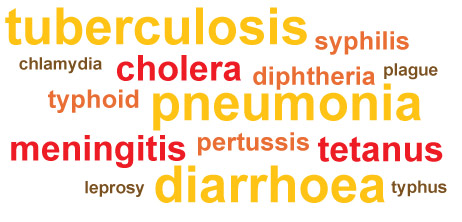3.8 Bacterial pathogens
Bacteria are the Earth’s most ancient organisms, evolving over 3000 million years ago. They are also the most numerous: the mass of all the bacteria in the world may exceed the combined mass of all the plants and animals. Each bacterium is a single cell that can multiply very rapidly – in as little as 20 minutes in some species.
Most of the bacteria that live in or on the human body are beneficial. The number of ‘friendly’ bacteria living in your gut is around 10 times the number of human cells in your whole body! These beneficial organisms are called commensal bacteria. Commensal [coh-mens-uhl] means ‘sharing the same table’ – a name that reflects the fact that some bacteria in the gut enable us to digest plant-based foods.
Commensal bacteria also have a role in protecting us from some infectious diseases. They occupy habitats in the body that could otherwise be colonised by pathogens such as Candida albicans, the fungus that causes thrush. Fungal cells that occur naturally in the mouth and vagina are kept in check as long as commensal bacteria occupy the available space and prevent the fungi from acquiring enough nutrients for growth. However, thrush often develops after treatment with antibiotics to control a bacterial infection.
Can you suggest why thrush is more common after taking antibiotics?
The antibiotics kill commensal bacteria as well as harmful ones; in the absence of commensal bacteria, fungal pathogens can obtain enough resources to multiply and cause the symptoms of thrush.
Over 500 species of pathogenic bacteria cause a diverse range of human infectious diseases. Some of the most important in terms of numbers of people affected are named in the ‘word cloud’ in Figure 13.
Here we will focus on just two categories:
- diarrhoeal diseases caused by bacteria transmitted via the faecal–oral route (i.e. transmitted from faeces to the mouth, usually on contaminated hands), and in food and water
- respiratory infections transmitted primarily by airborne bacteria.

